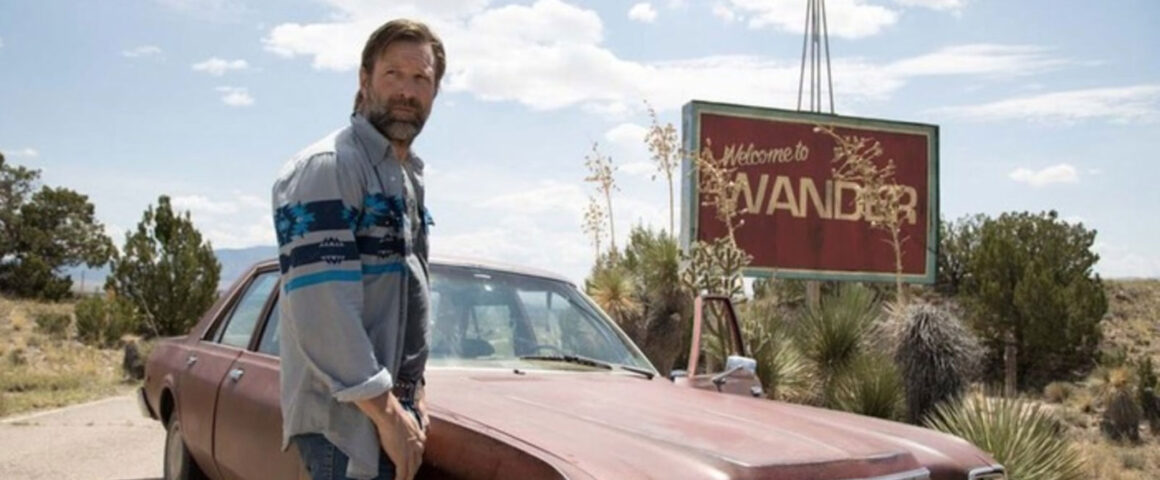The opening supertext of Wander draws attention to “indigenous, black, and people of color,” refers to “government violences,” and “change,” and highlights that the film was shot on the homelands of indigenous peoples. Released in 2020 shortly after the presidential election, it is tempting to see this film in the light of progressive change and a need for closer scrutiny of power structures and hierarchies, like other recent films that have sought to raise awareness about underrepresented groups such as “The Silencing” and “Drunktown’s Finest.” It is, therefore, a crushing disappointment that Wander not only fails to engage with these issues, but also offers a confusing and quite stupid mishmash of genre tropes rendered through a spiraling narrative and some seriously distracting storytelling.
The opening of the film shows promise, as the camera tracks along a road surrounded by desert scrubland, before arriving at an overturned pickup truck. A young woman, later revealed to be Zoe Guzman (Elizabeth Selby, “A Cry in the Night: The Legend of La Llorona”), emerges from the vehicle and starts to run, only to meet a mysterious death. From here, various figures appear and inspect the scene, make reference to wider events that the viewer can expect to be clarified later, and leave us with more questions than we started with. It’s a typical and effective opening, used functionally here although with less sense of menace or atmosphere than something like “Wind River.” The comparisons keep coming, and they don’t get more flattering.
Director April Mullen (“Below Her Mouth”) leans into the modern Western setting of Tim Doiron’s screenplay. The story emphasizes small figures within wide and potentially overwhelming environments, echoing “No Country for Old Men” and “Hell or High Water.” This conceit of scale includes the characters, vehicles and buildings within expansive vistas, lensed attractively enough by Russ De Jong and Gavin Smith. It also includes the narrative, which works as a neo-noir in the same vein as “Red Rock West” and “Sicario.” The titular town forms the main location, and its isolation from wider civilization recalls the frontier town of the western myth. Into this town that [insert law, God, society] forgot comes Arthur Bretnik (Aaron Eckhart, “Sully”), a grizzled ex-cop, now private investigator, with a tragic history and a massive conspiracy complex to boot (although no drinking problem, must have missed that at the Cliché-Mart). Arthur is a man beyond the edge, living in a converted trailer out in the New Mexico desert, on an area of land literally named “Middle of Nowhere.” Making him a conspiracy theorist is potentially interesting, as Arthur and his slightly less-unhinged friend Jimmy Cleats (Tommy Lee Jones, “Ad Astra,” creating another intertextual link to “No Country for Old Men”) record a conspiracy theory podcast. When contacted and subsequently hired by the mother of Zoe Guzman, Arthur sets out to investigate what happened.
Arthur as a protagonist opens the film to criticisms of the white savior complex. A town where indigenous, immigrants and people of color are under threat requires the intervention of a white figure of authority to save them from, something. Ah, you might say, but Arthur is hardly a savior, since he walks with a limp and is clearly mentally unstable. Arthur’s instability is emphasized through the repeated use of flashbacks and hallucinations, recalling the death of his family as well as a previous case that he worked on. These moments as well as others make the film reminiscent of “Shutter Island,” and like that film Wander refers to wider issues, including crime and immigration, government control and mental health. However, these various elements receive little more than lip service that comes across as lazy rather than interested. If the film is attempting to critique or unpack the white savior archetype, it needed to do more not to deliver a pretty perfunctory take on mental health.
Eckhart does a decent job of portraying someone struggling with reality, and he bears the physicality of Arthur well with his rolling gait and weighted stance. The other performances are mostly fine, although Heather Graham (“Wetlands”) is wasted as Shelley Luscomb, Arthur’s friend and, when the plot requires, lawyer. For Batman fans, there is some fun to be had in seeing two versions of Harvey Two-Face go face-to-face (pun intended), and one may wonder if Jones and Eckhart compared notes on such things. However, neither have much to work with in the script, and the development for Jimmy is as creaky as the rusted doors forced open at some points. As Elsa Viceroy, Katheryn Winnick (“The Dark Tower”) comes off the best, bringing genuine steel as well as mystery to her role as well as the film overall.
While the convolutions of the plot might be acceptable, what ultimately makes Wander unforgivable is Mullen’s near hysterical visual style. From that opening long tracking shot, we are treated to an almost constantly mobile camera that serves to distract rather than engage. At times, the camera rushes towards a location, only to then retreat at equal speed. This device is at least narratively motivated, but other visual tics seem intended only to remind us again and again that ARTHUR IS UNSTABLE. Yes, thank you, we got it, could we have some show, don’t tell please? The spinning narrative and style reach their zenith (or nadir) in the film’s climax, which could have been tragic and emotionally resonant. Instead, it leaves one with the feeling that everything we have seen was rather stupid, but with an earnestness that removes any sense of shlocky fun. Indeed, for all the mirth at the end, the final moments may leave you thinking that the last laugh is on you.



